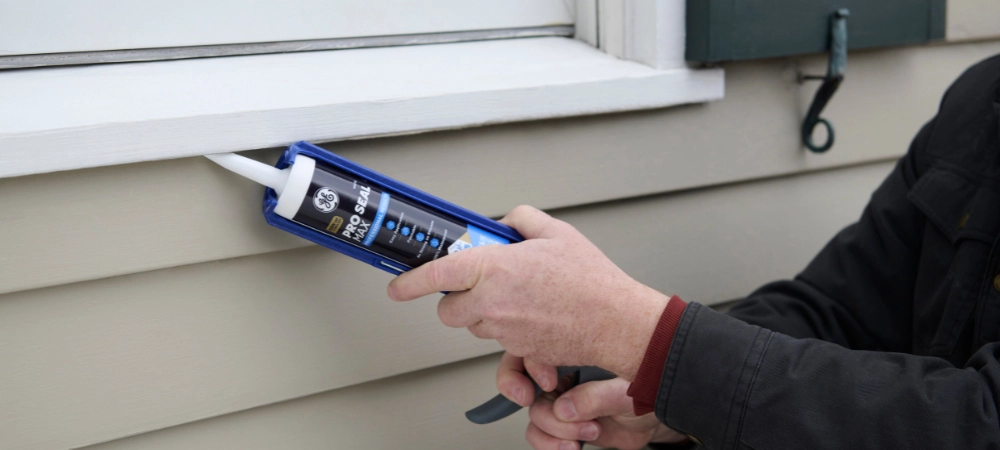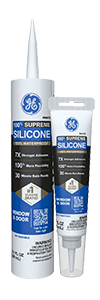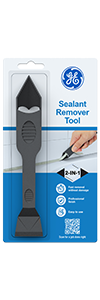Note: This DIY article is provided as a general guide only and is not intended to take the place of product-specific installation procedures; always follow applicable manufacturers’ instructions. Depending on your home’s age and condition, location within the home, and other potential factors, repairs and/or upgrades or other services may be necessary prior to the beginning and/or completion of your project that may involve the services of a home improvement professional. This article does not include advice pertaining to local building codes and/or any related inspections.
Before summer storm season hits, seal the spots that take the worst of it: flashing seams, gutter joints, window trim, and foundation edges. One small gap—one big risk. That’s how summer storm damage begins. This guide shows you what to seal, where to check, and which GE products hold up when it matters most.
What summer storm damage really looks like
Summer storm damage rarely announces itself. It shows up after the fact: in ceiling stains that spread overnight, baseboards that feel soft underfoot, or trim that swells and pulls away from the wall.
You might not notice it right away. But by the time it’s visible, the water’s already soaked insulation, fed mold behind drywall, and crept into wood framing.
What looks like a surface fix often starts with a missed seam, a cracked joint, or a gap no one thought needed sealing. These are the weak spots water finds first.
Four zones to seal before the season turns
Summer storms test your home one seam at a time. And it doesn’t take much—just one unsealed joint, worn bead, or overlooked edge.
To protect your home from storm damage, focus on the four zones that take the brunt of wind, rain, and runoff: roof flashing, gutters and downspouts, windows and doors, and foundation edges.
Start at the top and work your way down—just like water.
Roof flashing
Stormwater often damages the flashing first—the last place most people check. Wind-driven rain pushes under lifted ridge caps, seeps through aging sealant around vents, or follows a seam near skylights straight into your attic. If flashing seams aren’t sealed right, that’s how storm damage begins—and spreads fast.
For exposed roof joints like these, use GE Supreme Silicone Window & Door Sealant—a go-to option when sealing for storms. It’s built to hold up in the most exposed spots—rated Class 50 under ASTM C920 for high joint movement and long-term durability in extreme temperatures.
Pro tip: For gaps wider than 1/4 inch insert a backer rod first. Then use the GE Smoothing Tool to finish the sealant in one clean pass—no air pockets, no mess.
Gutters & downspouts
Gutters don’t just carry water—they protect everything below them. If seams leak or brackets pull away, runoff can spill behind the siding, soak fascia boards, or flood the soil around your foundation. That’s how minor gaps turn into major repairs—and why you should seal your gutters to protect your home from storm damage.
To seal these gutter joints properly, use GE Gutter Silicone Sealant. Even in standing water, it won’t peel, shrink, or create mildew—and it bonds to metal, vinyl, and painted surfaces. Just scrape away any loose material, let the surface dry fully, and apply a clean bead. Tool it flat with the GE Smoothing Tool.
For a deeper dive into how to assess and seal common gutter issues, check out this guide to gutter repair using sealant.
Water doesn’t just run off your home—it finds a way in. Usually around the frames.

Windows & doors
When wind-driven rain hits your home, it hits the frames first—windows, doors, and the seams around them. If trim joints or sill corners aren’t sealed tight, you lose the first line of defense in waterproofing your home. Water slips behind the siding or seeps into wall cavities. Most damage starts with a slow drip—nothing dramatic.
Seal these joints with GE Pro Seal Max Window & Door. Here’s why it works:
- Rain-ready in 30 minutes
- High joint movement (35%), Class 35 under ASTM C920
- Excellent adhesion—wet or dry, on wood, vinyl, metal, or fiber cement
- Won’t yellow or crack under sun, rain, or freeze
- Paint-ready in 60 minutes and is low odor
- Backed by a lifetime guarantee
GE Pro Seal Max: Built to flex with your home—not against it. C920 Class 35 performance means it expands and contracts without cracking or pulling away.
Unsealed sill edges wick water like a sponge—and drip behind drywall. Even if you seal top to bottom, don’t ignore what rests against the ground.
Foundation edges
The lower your sealant line, the easier it is to miss—and the more it matters. Gaps where siding meets concrete or brick let in splashback, pooled runoff, and wicking soil moisture. That’s how water finds its way behind siding and into basement walls.
Seal those seams with GE Silicone Concrete. It’s designed for masonry, stays flexible after cure, and bonds strong to concrete, brick, and stone. Just remove loose debris, clean and dry the surface, and apply a bead. For crisp edges, use masking tape when sealing against rough materials.
It’s a small step with serious weight in total home weatherproofing.
If there’s a gap between your slab and your siding, that’s not ventilation—it’s an open invitation.

Final storm sealing checklist
Follow this storm sealing checklist before and after every seal:
- Use a GE Sealant Remover Tool to lift out cracked or peeling sealant before you start
- Scrape out old sealant or debris
- Clean with isopropyl alcohol
- Let surfaces dry fully
- Use a caulk gun with smooth pressure
- Apply GE product by zone
- Tool the bead with the GE Smoothing Tool or a gloved finger
- Let cure for 24–48 hours (don’t rush it!)
- Recheck seasonally
A clean line and full cure are the real anchors of home weatherproofing.
FAQs
What’s the best sealant if rain is coming soon?
Use GE Pro Seal Max Window & Door. It’s rain-ready in just 30 minutes, so you can seal and stay ahead of the weather.
Can I paint over these sealants?
Yes—GE Pro Seal Max is paintable after about an hour.
Should I seal the inside and outside of my home?
Always start outside. If you only seal indoors, moisture can still get into the wall, but it won’t have a way out. That’s how hidden damage begins.
Ready to seal your home before the next storm? Find GE sealants at a retailer near you in the U.S. or Canada.




